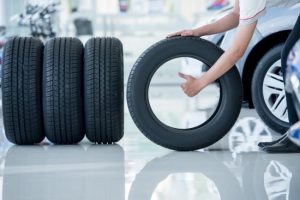Your tires are subject to constant wear as you drive due to friction with the surface. They can also be damaged by environmental conditions like extreme heat or cold and even direct sunlight. Safe driving requires good tires, and as your Buick dealership, we’d like you to know some of the signs you need to visit us for new tires.
Signs You Need New Tires from Your Buick Dealership
Low Tread

The tread is the raised section of a tire that’s in contact with the surface. Due to this surface contact, it’s also the part of the tire that will wear the fastest due to the constant abrasion. It’s interspersed with grooves that serve to channel water or mud backward to prevent it from collecting underneath the tread and potentially causing the tires to skid.
As the tread level drops, you’ll notice that your brakes take longer to work, and handling, particularly on wet surfaces, becomes more difficult. The minimum safe tread depth is 2/32″. If your looks low, you can test it with a tread depth gauge or by visiting our service department where we’ll check it for you. If your tread is low, we can replace any worn tires so you can drive safely again.
Underinflated Tires
Your car manual gives the correct tire pressure for all your tires. The tire pressure for your front and rear tires is often different, and this is due to the weight distribution on your Buick and the type of drivetrain it has. We recommend regularly checking your tire pressure, as underinflated tires will suffer extra wear and tear.
Underinflated tires will sag slightly on each side, and this brings part of the softer sidewall into contact with the surface. The sidewall isn’t reinforced with the steel and polymer bands the tread has, and the rubber will wear much faster. We can check the tire pressure for you and inflate the tires to the correct level if necessary. We’ll also examine tires for any damage and then recommend if they need replacement.
Overinflated Tires
This situation is the opposite of the problem above. In this case, the tires have too much air, which is just as dangerous. When you’re driving, the friction generated by a tire moving over the surface causes the air inside the tire to heat up. This is even more important on a hot day, as this will cause the air to heat up even faster.
When the air inside a tire heats up, its pressure increases. Overinflation causes the rubber to stretch slightly, which makes the tire surface thinner and weaker. Combined with the increased pressure inside the tire, an over-inflated tire could blow out and lead to an accident. We’ll check your tires and replace any damaged ones.
If your tires are worn or damaged, visit us today at Earnhardt Buick GMC in Mesa, AZ.






